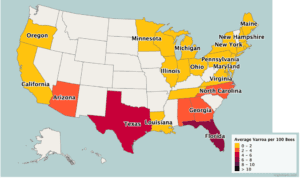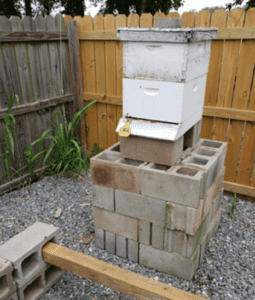 I don’t know about you, but my back hurts, which must mean the peak beekeeping season is officially well underway. The honey is flowing and supers are filling up. Do you know what your mite loads are? If not, Sentinel Apiaries are here to help. Sentinel Apiary participants sample 4 or 8 colonies for Varroa every month during the peak beekeeping season. This year marks the largest year of the Sentinel Apiary Program to date with 102 registered Sentinel Apiaries! If there’s a Sentinel Apiary near you, check their mite loads at bip2.beeinformed.org/sentinel. This can help show you what mites are doing in your neighborhood. Now that the first month of the program is complete, we’d like to begin a series of monthly Sentinel updates to share results with the BIP community.
I don’t know about you, but my back hurts, which must mean the peak beekeeping season is officially well underway. The honey is flowing and supers are filling up. Do you know what your mite loads are? If not, Sentinel Apiaries are here to help. Sentinel Apiary participants sample 4 or 8 colonies for Varroa every month during the peak beekeeping season. This year marks the largest year of the Sentinel Apiary Program to date with 102 registered Sentinel Apiaries! If there’s a Sentinel Apiary near you, check their mite loads at bip2.beeinformed.org/sentinel. This can help show you what mites are doing in your neighborhood. Now that the first month of the program is complete, we’d like to begin a series of monthly Sentinel updates to share results with the BIP community.
Throughout the month of May, over 330 Sentinel Varroa and Nosema samples were processed by our diagnostics lab! Apiaries were sampled in 26 states across the country. Typically, the trend is that mite loads increase faster in the south than they do in the north. This makes sense because the warm southern climate allows colonies to brood up earlier, and mites depend on capped brood to reproduce. This year’s Sentinel Apiaries have shown just this, with May mite loads higher in the south than the north. So far, of the participating states, Arizona, Texas, Alabama, Georgia, Florida and North Carolina have exceeded an average of 2 mites/100 bees in Sentinel Apiaries.. So if you’re in the south, be sure to monitor next time your colonies are super free and get a treatment in if you need one.

All other participating states are still well below threshold at an average of 0-2 mites. A big congratulations to Wisconsin for having this month’s lowest mite load at 0.09 mites/100 bees! This is great news for northern beekeepers, who have seen colder and wetter weather than typical, but be sure to still monitor if you’re planning on adding supers soon. It’s important to make sure your mite levels are as low as possible if it’s going to be a while before you get back down to the brood nest to sample. It’s only a matter of time until mite loads rise throughout the country.

Another observation from early Sentinel samples is that weather has been anything but normal. Sentinel participants report on whether their climate has been atypical, and many participants cite heavy rains and abnormal temperatures as negatively impacting their colonies. There has been substantial rain and flooding throughout much of the Midwest and plains regions. Beekeepers are having trouble getting queens well mated, as well as producing honey since there have been so few days with flyable weather. It’s been a rough start to the year for many, but everyone is hoping things will calm down soon in time for the last couple months of summer.
We’re just getting started and we would love to hear from you. As the season progresses, we’ll be sharing some interesting data in these monthly blogs and hope to have some Sentinel participants share how their monthly monitoring is changing how they manage their colonies. Get ready, hold on and take care of your back!